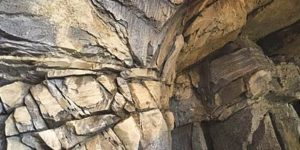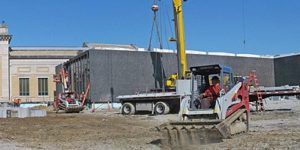 The crew at Airspeed Skateparks was laboriously gluing ceramic tiles to vertical areas in our public skatepark projects until we were introduced to concrete stamping by Concrete Decor in 2001. Once exposed to the possibilities, we switched from traditional tile setting to all-concrete stamped tiling. There are many advantages. Tile stamping happens the same day as the initial pour, saving setup time and labor. It’s easier and faster to stamp tile on vertical walls than to prep and apply ceramic tiles. Stamping tiles makes particular sense in regions exposed to drastic freeze-thaw cycles: Glued-on tiles can pop off during cold weather when moisture freezes between the tiles and their substrate. We’ve found that most people don’t even realize that stamped tiles are concrete instead of ceramic. They create the ambience of ceramic tile without the misery of tile prep and setting.
The crew at Airspeed Skateparks was laboriously gluing ceramic tiles to vertical areas in our public skatepark projects until we were introduced to concrete stamping by Concrete Decor in 2001. Once exposed to the possibilities, we switched from traditional tile setting to all-concrete stamped tiling. There are many advantages. Tile stamping happens the same day as the initial pour, saving setup time and labor. It’s easier and faster to stamp tile on vertical walls than to prep and apply ceramic tiles. Stamping tiles makes particular sense in regions exposed to drastic freeze-thaw cycles: Glued-on tiles can pop off during cold weather when moisture freezes between the tiles and their substrate. We’ve found that most people don’t even realize that stamped tiles are concrete instead of ceramic. They create the ambience of ceramic tile without the misery of tile prep and setting.
Stamping
Prep your tile stamp first with Bubble Gum Liquid Release.
Michael Dahl, who makes all of our stamps, makes a few full-size stamps and then cuts them up into different sizes — one row, two rows, etc. — which allows for the different curves of the park. It’s also helpful to cut a few blocks of 2-inch rigid insulation foam the size of the stamps to use as tampers. You can also use the edge of the foam block to touch up grout lines.
The first step is to place the mud and shape it correctly. We usually stamp tile on vertical surfaces, so we shoot it with shotcrete and shape it with swimming pool tools. Use a cheap, plastic level to make your concrete totally vertical if that’s your intent. Without overworking, we float the cream to the top with a fiberglass float with minimal passes. Seal the surface with a steel pool trowel.
When you feel that all the elements are aligned in your favor, spray or brush on the Bubble Gum release, then place the stamp where you want it, hold the foam block on top of the stamp and tap to get the impression desired. Adjust the intensity of your tapping to suit the hardness of the concrete as you progress. Take one corner of the stamp and peel back slowly. Should there be a section that did not get completely stamped, carefully roll back the stamp, apply release and repeat the tapping procedure. If the stamping took to your liking, remove the stamp all the way.
As is typical of working with concrete, one often encounters problem areas while stamping tile. If you are tiling a complex shape or the mud consistency is not ideal, the initial impression may be flawed. Don’t panic — it’s easy enough to manicure the stamp with small, improvised tools like a nail. If the tile surface is too fuzzy when you pull the mold, the concrete needs to set a little longer, or you need to apply more release. Custom tools can be made to match difficult areas or clean up sloppy grout lines. Nearly every job site is replete with miscellaneous objects that will serve your purpose. Always remember that you are the master of the mud, not the other way around.
Staining and sealing
There are a plethora of acid stains to choose from. We usually use Teal Blue acid stain for our tiles. It yields a brilliant turquoise reminiscent of the classic swimming pool tiles of ’70s suburbia.



















